circuits
schematics
diagrams
FreeCircuits.net

Wailing Alarm Siren
By Tony van Roon

Wailing Alarm Siren circuit
Parts List:
R1,R5 = 4.7K
C1,C4 = 100uF/25V, electrolytic
R2 = 47K
C2,C3 = 0.01uF (10nF), ceramic
R3 = 10K
Q1 = 2N3702 (NTE159, TUP, etc.)
R4 = 100K
IC1,IC2 = LM555, NE555, uA555
*Rx = See text
LS = Loudspeaker (see text)
Notes:
IC2 is wired as a low frequency astable with a cycle period of about 6 seconds.
The slowly varying ramp waveform at C1 is fed to PNP emitter follower Q1, and is
then used to frequency modulate alarm generator IC1 via R6. IC1 has a natural
center frequency of about 800Hz.
Circuit action is such that the alarm output signal starts at a low frequency,
rises for 3 seconds to a high frequency, then falls over 3 seconds to a low
frequency again, and so on.
* The Loudspeaker LS and the resistor marked "Rx" should be together 75 ohms. If
you have a standard 8-ohm speaker then Rx is 67 ohms. The nearest value is 68
ohms. So for a 8 ohm loudspeaker Rx is 68 ohms. For a 4 ohm loudspeaker Rx is 71
ohms, for a 25 ohm loudspeaker Rx is 50 ohms, etc. The Rx value is not very
critical. It is just there as some sort of volume control, experiment with it.
C2 and C3 are 0.01uF (10nF) and a simple ceramic type will do the job. I tested
the circuit at 9, 12, and 15 volt. My personal choice is the 9 volt alkaline
type for battery operation, or 12 volt for use with a small powersupply. The so-called
9V NiCad will not work properly. The actual voltage for this NiCad type is
actually only 7.5V (6 cells x 1.2V = 7.5V)
Just in case you're wondering, output pin 3 of IC2 is NOT connected! In the
prototype, I used LM555 timers.
 3105
3105 ![]() 21 August 2007
21 August 2007
